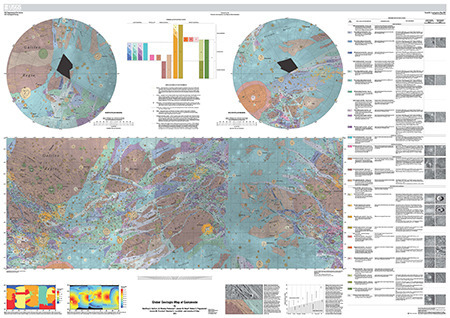Paul Gilster's Blog, page 207
February 26, 2014
Science Fiction in Extreme Environments
I’ve had pulsars on the mind the last couple of days after our discussion of PSR 1257+12 and its contribution to exoplanetology. A bit more about pulsars today and the way we look at extreme objects through science fiction. PSR 1257+12 was discovered in 1990 by Aleksander Wolszczan using data from the Arecibo dish, and it was in 1992 that Wolszczan and Dale Frail published a paper outlining their discovery of the first planets ever found outside our Solar System. The two planets were joined by a third in 1994, but evidence for a fourth was later shown to be mistaken. In any case, the three planets confounded many astronomers, who hardly expected the first extrasolar planets to be found orbiting a radiation-spewing neutron star.
Centauri Dreams regular Al Jackson was co-author of a 1992 study of PSR1257+12 that examined orbital resonance in the planets around the pulsar. In a note last night, Al mused “Just think of a K2 civilization setting up a research station on one of those to study a pulsar – maybe someone has written the SF story?” I can’t think of a story specifically targeting a pulsar planet, though if memory serves, Alastair Reynolds deals with a pulsar in one of the early Revelation Space novels. But the notion reminds me of other extreme environment classics like Hal Clement’s Mission of Gravity (1954), which covers the fantastically spinning world Mesklin, where surface gravity gets up close to 700 g at the poles.
High-energy environments are made to order for hard science fiction. Consider what our best authors might do with this: The pulsar IGR J11014-6103, now the subject of observations by the Chandra X-Ray Observatory, is producing a jet of high-energy particles that this Chandra news release claims is the longest of any object in the Milky Way, a whopping 37 light years. The pulsar is moving away from a supernova remnant in the constellation of Carina at a speed somewhere between 1100 and 2200 kilometers per second, making it one of the fastest moving pulsars yet observed.
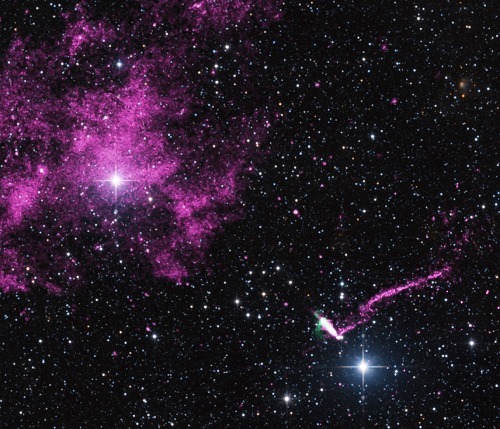
Image: An extraordinary jet trailing behind a runaway pulsar is seen in this composite image that contains data from NASA’s Chandra X-ray Observatory (purple), radio data from the Australia Telescope Compact Array (green), and optical data from the 2MASS survey (red, green, and blue). The pulsar – a spinning neutron star – and its tail are found in the lower right of this image. The tail stretches for 37 light years, making it the longest jet ever seen from an object in the Milky Way galaxy. Credit: X-ray: NASA/CXC/ISDC/L.Pavan et al, Radio: CSIRO/ATNF/ATCA Optical: 2MASS/UMass/IPAC-Caltech/NASA/NSF.
A 37 light-year jet is remarkable enough (nine times the distance to Proxima Centauri!), but we also find that there is a corkscrew pattern in the jet suggesting that the pulsar is wobbling as it spins. In addition, it’s producing a comet-like tail behind it due to the effects of a pulsar wind nebula (PWN) — a sheath of high-energy particles that enshrouds the pulsar. And while a pulsar’s direction of motion is usually aligned with its jet and the pulsar wind nebula around it, IGR J11014-6103’s own PWN is almost perpendicular to the direction of the jet, possibly indicating high rotation speeds in the iron core of the supernova that produced the pulsar.
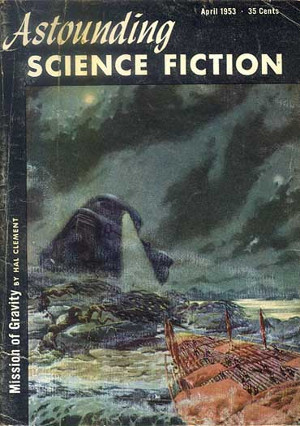
It’s fascinating to explore such extreme environments, and one of the things I love about science fiction is that a combination of scientific rigor and imagination can let us see things like this up close. Clement’s Mesklin was put together using a carefully wrought model that the author went on to describe in an article called ‘Whirligig World,’ which ran in Astounding Science Fiction in June of 1953. He based it on an object then believed to exist in the 61 Cygni system, and although the latter turned out to be a chimera, his concern for getting the science right built a memorable world we can still enjoy reading about today. Now who will take up Al Jackson’s challenge to describe a research station on a pulsar planet?
Image: The April, 1953 issue of Astounding contained the first installment of Hal Clement’s Mission of Gravity, published in book form the following year.
The paper on the light jet is Pavan et al. “The long helical jet of the Lighthouse nebula, IGR J11014-6103,” Astronomy & Astrophysics 562 (2014): A122 (preprint). Al Jackson’s paper on PSR 1257+12 is Malhotra et al. “Resonant orbital evolution in the putative planetary system of PSR1257 + 12,” Nature 356 (16 April 1992), pp. 583-585 (abstract).






February 25, 2014
Tau Boötis b: A ’3-D’ Look at Star and Planet
Strong evidence for water in the atmosphere of the hot Jupiter Tau Boötis b has turned up, thanks to work by Geoffrey Blake (Caltech) and graduate student Alexandra Lockwood. But what’s intriguing about the find isn’t the water — we’ve found water vapor on other planets — but the method of detection. Lockwood and Blake used a modified radial velocity technique that has previously been deployed to detect low mass ratio binary stars. A top-flight instrument like the Near Infrared Echelle Spectrograph (NIRSPEC) at the W. M. Keck Observatory in Hawaii can separate the planetary and stellar components spectroscopically to produce this result.

Image: Simulated data showing the method used for detecting water vapor features around the hot Jupiter tau Boötis b. In this example, the planetary signal has been increased in strength by several orders of magnitude relative to the actual signal. The dotted lines show the blue- and red-shifts of the planetary and stellar lines in the data, respectively. Credit: Alexandra Lockwood/Caltech.
Thus the toolkit of exoplanet science continues to grow. We already know how to study planetary atmospheres when a planet transits its primary as seen from Earth, allowing us to separate direct light from the star from light that has passed through the atmosphere. Another way of studying an atmosphere is through direct imaging, but here we rely on planets far enough from their host star that we can separate them from the star’s glare, the classic problem of planet hunters. But a non-transiting world like Tau Boötis b demands a different approach, and the spectroscopic separation of radial velocity signals appears to be one solution.
Lockwood is lead author of the paper on this work, which appears in The Astrophysical Journal Letters:
“The information we get from the spectrograph is like listening to an orchestra performance; you hear all of the music together, but if you listen carefully, you can pick out a trumpet or a violin or a cello, and you know that those instruments are present. With the telescope, you see all of the light together, but the spectrograph allows you to pick out different pieces; like this wavelength of light means that there is sodium, or this one means that there’s water.”
It was back in 2012 that two independent teams studying Tau Boötis b were able to separate the radial velocity of the planet from that of the star by studying shifts in the spectral lines of carbon dioxide. The technique as expanded into the infrared now gives us the molecular signature of water. I should mention here that a team in 2010 detected carbon monoxide in the atmosphere of another hot Jupiter, the much studied HD 209458 b, a detection that provided what researchers call the ‘spectroscopic orbit’ of the system and thus revealed the true mass of the planet.
So more is at play here than the detection of yet another component of a hot Jupiter’s atmosphere. Separating the two radial velocity components helps to determine a planet’s mass, which in earlier radial velocity studies could only be an estimate of the planet’s minimum mass. The actual mass could be much higher than what astronomers could measure, given their lack of knowledge about the inclination of the planet to the star. By detecting a signature from both planet and star, this method allows us to explore the system in greater detail. From the paper (with reference to the 2012 work on carbon dioxide mentioned above):
…this technique can be applied to non-transiting, RV-detected exoplanets to extract the unknown inclination and true mass. CRIRES [the High-Resolution IR Echelle Spectrometer installed at ESO’s Very Large Telescope] was also used to detect CO on τ Boötis b (Brogi et al. 2012), the first ground-based detection of a short-period non-transiting exoplanet atmosphere, a result confirmed shortly thereafter by Rodler et al. (2012). These studies provide the true mass of the planet and probe the chemical composition of its atmosphere. A combination of high signal-to-noise, high spectral resolution, and coverage of multiple CO overtone lines was required to achieve the sensitivity required for these detections.
So by finding the signature of water in the atmosphere of Tau Boötis b, the Caltech team is also extending work that creates what Lockwood calls the ‘3-D motion of the star and the planet in the system.’ It’s a method that deepens our understanding of the planetary system by giving us a true mass reading, and although at present its applications are limited to close-in gas giants like Tau Boötis b around nearby bright stars, the hope is that improvements in telescopes and infrared spectroscopy will extend the method to smaller planets around dimmer stars.
“While the current state of the technique cannot detect earthlike planets around stars like the Sun, with Keck it should soon be possible to study the atmospheres of the so-called ‘super-Earth’ planets being discovered around nearby low-mass stars, many of which do not transit,” adds Blake. “Future telescopes such as the James Webb Space Telescope and the Thirty Meter Telescope (TMT) will enable us to examine much cooler planets that are more distant from their host stars and where liquid water is more likely to exist.”
The paper is Lockwood et al. “”Near-IR Direct Detection of Water Vapor in tau Boötis b,” The Astrophysical Journal Letters, published online 24 February 2014 (preprint).






February 24, 2014
A Formation Mechanism for Pulsar Planets?
CSIRO, the Commonwealth Scientific and Industrial Research Organisation in Australia, is announcing the detection of violent events around the pulsar PSR J0738-4042, some 37,000 light years from Earth in the constellation Puppis. This southern hemisphere constellation was originally part of a larger constellation called Argo Navis, depicting the ship made famous by the journey of Jason and the Argonauts. But Argo Navis was divided into three smaller constellations, leaving Puppis (The Stern) as something of a mythological fragment.
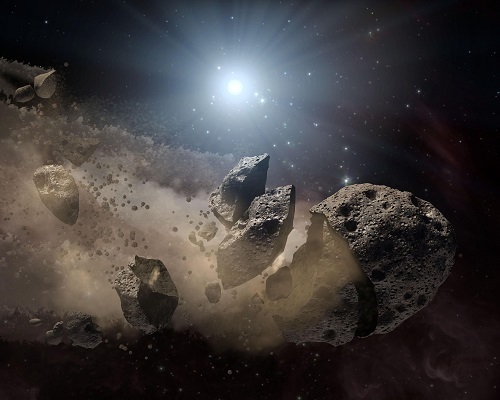
Image: An artist’s impression of an asteroid breaking up. Credit: NASA/JPL-Caltech.
Whatever its origins, Puppis is also home, from our Earthly perspective, to a pulsar around which radiation and sleeting high energy particles are common. Ryan Shannon, a member of the CSIRO research team, has previously examined how an infalling asteroid from a violent disk around a pulsar might affect it, slowing the pulsar’s spin rate and affecting the shape of the radio pulse that we see on Earth. That’s a useful signal, because pulsars flash a radio beam with great regularity, so that any disruptions call attention to themselves. Says Shannon:
“That is exactly what we see in this case. We think the pulsar’s radio beam zaps the asteroid, vaporising it. But the vaporised particles are electrically charged and they slightly alter the process that creates the pulsar’s beam.”
Long term monitoring has shown that the pulse shape of PSR J0738-4042 changes multiple times between 1988 and 2012, with one event that implies a rock of about a billion tonnes interacting with the pulsar. The abstract of the paper on this work summarizes the finding:
The torque, inferred via the derivative of the rotational period, changes abruptly from 2005 September. This change is accompanied by an emergent radio component that drifts with respect to the rest of the pulse. No known intrinsic pulsar processes can explain these timing and radio emission signatures.
And so we get an interesting mechanism for the formation of large objects around a pulsar. Dust and debris formed in the original stellar explosion that gave birth to the pulsar itself could fall back toward the spinning remnant to create a debris disk that, in turn, gives birth to larger objects. Recall that two planet-sized objects were detected in 1992 around the pulsar PSR 1257+12, though not necessarily formed by the same mechanisms (a third planet was detected five years later). We have much to learn about the various ways pulsar planets may form.
The environment that spawns these results has to give us pause. “If a large rocky object can form here,” Ryan Shannon adds, “planets could form around any star.” True enough, though we should add that pulsar planets still seem to be the rarest of the breed. In any case, this detection is remarkable. We’re reaching out to a distance far larger than that between the Earth and the galactic core to track conditions in this system. With so many ongoing projects, we can all too easily become blasé about just what is happening here, but let’s keep that sense of wonder at full throttle. Twenty-five years ago we had no confirmed exoplanets, and now we’re investigating asteroids in a system 37,000 light years from Earth? A golden era of discovery indeed…
The paper is Brook et al., “Evidence of an Asteroid Encountering a Pulsar,” Astrophysical Journal Letters Vol. 780, No. 2 (2014), L31 (abstract).






February 21, 2014
Extraterrestrial Dispersal Vectors
If human civilization is to extend itself beyond our planet, it will need to take with it the plants, animals and microorganisms that can sustain a living ecosystem. Nick Nielsen argues in this compelling essay that preserving our own species into the remote future thus means preserving terrestrial biology as well, drawing sustenance from it and maintaining it long enough for Earthly systems — and ourselves — to evolve in the myriad environments that await us among the stars. Mr. Nielsen’s examination of future speciation continues his ongoing series on existential risk and the nature of human expansion. You can keep up with his thinking on his two blogs: Grand Strategy: The View from Oregon and Grand Strategy Annex, or follow him on Twitter, where he is @geopolicraticus.
by J. N. Nielsen

Some time ago on Twitter I wrote, “Astrobiology is island biogeography writ large.” As in the classic science fiction film This Island Earth, we know our world to be an island oasis of life in the midst of a dark and possibly barren cosmic ocean of space. Astrobiology, in seeking to understand the place of life in the universe, seeks to understand our oasis of life in a cosmological context. Perhaps we will be forced to reconcile ourselves with an unrelieved cosmic loneliness; perhaps we will find that life is plentiful in the universe; perhaps life will be found to be so plentiful that it seems likely that life on earth is a consequence of panspermia. Whatever the result of our search, whatever remarkable discoveries we make, complex multicellular life like ourselves is likely to require some kind of homeworld for its initial evolution, and these worlds are likely to be distributed across widely separated worlds. Astrobiology is the cosmic biogeography that can serve as the field guide to this archipelago of habitable worlds.

The existence of galactic habitable zones (GHZ) and circumstellar habitable zones (CHZ) [1] implies regions of greater and lesser habitability, and the distribution of stars, planets, moons and other matter within the GHZ and CHZ implies worlds of greater and lesser habitability. A recent paper on Superhabitable Worlds [2] has suggested that there may be planets or planetary systems more clement to life than the environment of Earth. This implies the possibility that, although Earth looks like a unique oasis in the darkness of space, it may represent a cosmic region of sub-optimal habitability. At very least, we have much to learn about habitability, given the present necessity of extrapolating from a single data point. It seems, however, than in spite of our ignorance of life elsewhere in the cosmos we must first attempt to map the habitable zones of the universe if we are to search for the life that would supervene upon these habitable zones. The resulting patterns of habitability and life that we will eventually be able to map will be our biogeography of the cosmos – a kind of biocosmography or bioastrography – and we will want to consider the relationship between forms of life that occur at nodal points of habitability, if there are any such relationships.
Biogeographers in discussions of species distribution distinguish between stepping-stones routes, single-step routes, and sweepstakes routes of species dispersal. A stepping-stones route is a gradual process that is integral with the evolution of a species, which expands its range as its population grows, slowly covering a landscape. A single-step route is when, “organisms cross a barrier in a direct, single event, not sequentially.” [3] A sweepstakes route is dispersal via a vector that is rare and unusual. Many islands are eventually colonized by sweepstakes routes, which accounts for their distinctive flora and fauna. A lizard that happens to ride a floating log to an island and finds another lizard of the same species with which to perpetuate the species has experienced a sweepstakes dispersal route. Mostly on islands, one finds insects and birds and marine mammals, and few larger species that cannot fly or swim to the island under their own power.
Astrobiology will need to make similar distinctions among cosmological stepping-stones routes, single-step routes, and sweepstakes routes. We have already begun to understand some of the potential dispersal vectors. We know that a certain amount of matter is exchanged between the planets of our solar system, and it is possible that microorganisms have hitched a ride between planets on rocks blasted off the surface of a planet by some enormous impact. Under conditions prevailing in our solar system, however, we cannot expect that complex multicellular life could expand from our homeworld in this way.
In a superhabitable world or solar system, as noted above, it might be possible for complex, multicellular organisms to follow a stepping-stones route to dispersal beyond their homeworld, and thereby attain a far higher degree of existential viability than they would enjoy if they had remained an autochthonous species of a single celestial body. Apart from superhabitable worlds, on sub-optimally habitable worlds the scenario of single-celled microorganisms living on a piece of ejected debris that eventually finds itself on a celestial body other than its homeworld would constitute a paradigm case of a sweepstakes route.
It is possible to imagine circumstances of superhabitable worlds or even superhabitable solar systems in which the means provided by industrial-technological civilization are not necessary to the dispersal of life to other worlds, and a single-step route may be facilitated by naturally occurring means. In our perhaps sub-optimally habitable solar system, however, this is not possible. For the complex, multicellular life that we know and love on Earth, the only method of extraterrestrial dispersion would be a single-step route, the only dispersal vector would be a spacecraft, and the only way to produce a spacecraft is through a relatively advanced industrial-technological civilization.
Thus the long term existential viability of the terrestrial biosphere is predicated upon the growth and expansion of industrial-technological civilization, which seems paradoxical. In the early stages of industrial-technological civilization, up to and including the present day, the expansion of industrial-technological civilization has come at a cost to the terrestrial biosphere. It has even been suggested that another mass extinction is taking place, an anthropogenic mass extinction, as a result of human activity on Earth. Nevertheless, a vital technological civilization is, at least in our solar system, a necessary prerequisite to the survival of any life derived from the terrestrial biosphere once the Earth passes its natural span of habitability.
It is not only human beings that benefit from space travel and settlement; existential risk mitigation affects every living thing on Earth. If human beings establish a permanent and self-sustaining presence off the surface of the Earth, such an outpost of terrestrial life could only achieve a self-sustaining ecosystem through the parallel presence of thousands if not millions of other terrestrial species (keeping in mind that the majority of these species will be microorganisms, millions of terrestrial species do not necessarily impose insuperable spatial requirements for an off-world settlement). When we go into space, we must take with us the plants and animals that we eat or otherwise rely upon for our existential viability.
If we fail to utilize the resources of our industrial-technological civilization to lift ourselves and our fellow terrestrial species off the Earth, all that has been achieved by the terrestrial biosphere will be lost (i.e., it is not only humanity and civilization that are lost should we succumb to existential risk), except for the possibility of some extremophile microorganisms that might ultimately survive the dissolution of the Earth’s biosphere if blasted into space.
The natural lifespan of the Earth will eventually lapse and come to an end, and after that the natural lifespan of the sun, too, will be exhausted and lapse, which is why Wernher von Braun said, “The importance of the space program is to build a bridge to the stars, so that when the Sun dies, humanity will not die. The Sun is a star that’s burning up, and when it finally burns up, there will be no Earth… no Mars… no Jupiter.” [4] While his expression of the idea is anthropocentric, we can see that any bridge to the stars must also be a bridge for other terrestrial species as well as ourselves. In short, interstellar travel is a dispersal vector for terrestrial biology.
Once our terrestrial biology is extended to other worlds – initially, other worlds in our solar system, and then other worlds orbiting other stars – it will be subject to unprecedented selection pressures, and in the long term these selection pressures will result in speciation specific to the new environments in which terrestrial species gain a foothold. In other words, terrestrial life will continue to evolve, and it will evolve on other worlds in a way that it does not and would not evolve on Earth. Speciation on a cosmic scale will be the result. We do not know and cannot predict the direction that life will take in its adaptive radiation throughout the cosmos.
It will not be until the first terrestrial seeds are planted in lunar soil in a greenhouse on the moon, or in Martian soil in a greenhouse on Mars, that we will know what terrestrial plants grow well in these soils and under these conditions. Only experience can teach us this, as the interaction of organism and environment, especially under novel conditions, is too complex to predict with certainty, and life is a paradigm of contingency, subject to the thousand natural shocks that flesh is heir to.
If this ignorance of the consequences of space settlement for our own biology sounds like I am making light of our knowledge and abilities – after all, human beings have been farmers for more than ten thousand years – the idea is precisely analogous to another challenge faced by space travel. We do not yet know, and cannot predict on the basis of present knowledge of science, technology, and engineering, what technologies will prove to be the most robust forms of propulsion for interstellar vessels. Among the many concepts for interstellar propulsion that have been proposed there remains not only all the science yet to be done to confirm or invalidate the concept, but also the building of specific technologies on the basis of this science, engineering particular vehicles employing these specific technologies, and then the testing and proving of these vehicles in the kind of conditions that will only be faced in flight. In the same way, we do not yet know what terrestrial plants and animals will prove to be robust partners in space exploration.
We may eventually treat our food supply and sustainable ecosystem as an engineering problem, but that will compound rather than limit the unknowns of speciation. Because of our anthropocentric moral standards, we will likely have less moral compunction about modifying other species for their use on space settlements or other worlds; even then, species modified for our use in artificial environments (i.e., on shipboard and space settlements) or on other worlds (initially, Mars and moons in our solar system, and then other planets around other stars) will be subject to a twofold selection process that is only likely to accelerate their adaptive radiation, viz. these two selection pressures being the artificial selection resulting from human genetic engineering of other species and the natural selection of novel environments not encountered by any terrestrial species that remains on Earth.
Notes
[1] Cf. e.g., Astrobiology of Earth: The emergence, evolution, and future of life on a planet in turmoil, Joseph Gale, Oxford: Oxford University Press, 2009, p. 33
[2] Superhabitable Worlds, Heller, René and Armstrong, John. Astrobiology. January 2014, 14 (1): 50-66. doi:10.1089/ast.2013.1088.
[3] Trans-oceanic dispersal and evolution of early composites (Asteraceae) Liliana Katinas, Jorge V. Crisci, Peter Hoch, Maria C. Tellería, María J. Apodaca, Perspectives in Plant Ecology, Evolution and Systematics, Volume 15, Issue 5, 20 October 2013, Pages 269–280
[4] This was quoted by Friedwardt Winterberg at the Icarus Interstellar Starship Congress, Day 2; I have been unable to locate a source for this quote.






February 20, 2014
PLATO: Planet Hunter Selected by ESA
Following up on yesterday’s post on Gaia, it seems a good time to discuss PLATO, the European Space Agency’s planet hunting mission, which has just been selected for launch by ESA’s Science Policy Committee. The agency’s Cosmic Vision program has already selected the Euclid mission to study dark energy (launch in 2020) and Solar Orbiter, an interesting attempt to study the solar wind from less than fifty million kilometers. Solar Orbiter will surely return data we’ll want to discuss here in terms of magsails, electric sails and other ways to harness a solar wind about which we have much to learn.
Solar Orbiter’s launch is the closest of the three, scheduled for 2017, with PLATO pegged for 2024, the launch to be from the European spaceport in Kourou (French Guiana) aboard a Soyuz booster. Note that date, because it’s expected, as this BBC story notes, that the ground-based European Extremely Large Telescope (E-ELT) will be operational in Chile by 2024, a reminder that it should be powerful enough, with its 39-meter primary mirror, to carry out studies of planetary atmospheres as determined by targets PLATO can provide.
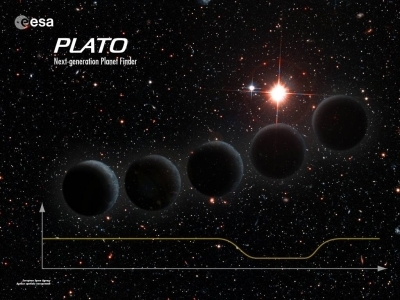
The mission will operate from the L2 Lagrangian point 1.5 million kilometers from the Earth, from which vantage PLATO will turn 34 individual telescopes and cameras on to a field of view that encompasses half the sky. Up to a million stars will be under investigation, looking for the characteristic lightcurve of a planet transiting the star as seen from Earth. PLATO will also have a strong asteroseismology component, allowing even more precision in characterizing its planetary finds, especially since these will be followed up with ground-based radial velocity observations that will benefit from having data on surface pulsations on target stars.
Thus PLATO’s unravelled acronym: PLAnetary Transits and Oscillations of stars. The ultimate goals are exactly those we’d expect: To discover and characterize relatively nearby planetary systems, detecting Earth-sized planets and ‘super-Earths’ in the habitable zone around solar-type stars while measuring solar oscillations in the host stars. Working at optical wavelengths, PLATO should be able to determine planetary mass with a precision of 10 percent, planetary radius with a precision of 2 percent and stellar age up to 10 percent.
The BBC quotes Don Pollacco (University of Warwick, leader of the PLATO Science Consortium), on how the mission differs from those that have gone before:
“PLATO will be our first attempt to find nearby habitable planets around Sun-like stars that we can actually examine in sufficient detail to look for life. Nearly all the small transiting planets discovered so far have been beyond our technology to characterise. PLATO will be a game-changer, allowing many Earth-like planets to be detected and confirmed and their atmospheres examined for signs of life.”
The contrast is, of course, with Kepler, whose stars — in a magnitude range between 7 and 17 — were faint enough that follow-up studies for the majority of candidates are difficult if not impossible. The interesting Lost in Transits blog, written by a PhD student at the University of Warwick and thus likely connected with Don Pollacco at the same school, points out that Kepler’s wide field and large camera array will be turned to brighter stars (magnitude 4-16) with equipment sufficient to follow up even small Earth-class planets around these stars. The blog also points to the effectiveness of asteroseismology in this work:
This ability to survey bright stars also allows astronomers to perform extremely sensitive measurements of the stars themselves. By using variations in starlight caused by ripples on the star’s surface, astronomers can accurately pin down not only the size of the star but also the age of the star system. This means, not only can Plato find exoplanets around bright stars, but it can also determine the size and age of many of these planets to a precision only previously dreamed of.
Ahead for PLATO are further refinements and finalization of the design, along with selection of an industrial prime contractor and, within the next two years, the final adoption of the mission, but the support given by the ESA Science Policy Committee, unanimous, strengthens our hopes that PLATO will fly. The fudge factor in that statement simply reflects the disappointments we’ve seen on both sides of the Atlantic with missions like SIM (Space Interferometry Mission) and the Darwin astronomical interferometer all showing promise only to face cancellation. Budgetary realities are always to be reckoned with, but PLATO’s selection is welcome news indeed.
For more detail on PLATO, see Rauer et al., “The PLATO 2.0 Mission” (abstract).






February 19, 2014
Chemical Change in a Protoplanetary Disk
The young star known as L1527 offers a spectacular view at infrared wavelengths, a result of the configuration of gas and dust around it. Have a look at the image below, taken by the Spitzer Space Telescope, where light from the star escapes through the opening provided by a bipolar gas flow, illuminating the gas to highlight a nebula in the shape of a butterfly. Earlier radio studies of this star have shown that L1527 is surrounded by a gas disk that, from our perspective, is seen edge-on. Now new radio observations are helping us characterize the gas itself.
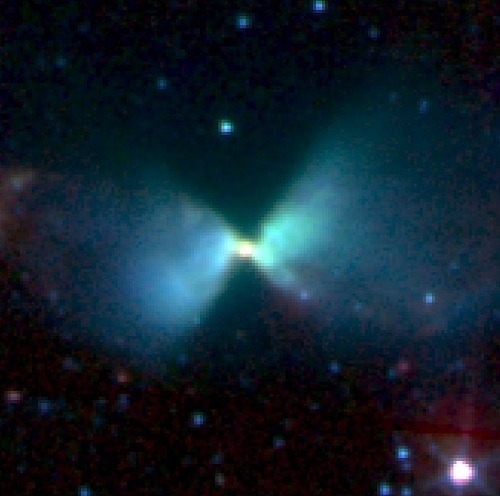
Image: An infrared image of the protostar L1527 taken by the Spitzer Space Telescope. Credit: J. Tobin/NASA/JPL-Caltech.
It’s an interesting investigation because the chemical changes inside a disk as it forms are little understood. Intense observational effort has gone into studying the physical structure of protoplanetary disks, but separating the young disk and the infalling envelope of gas and dust that gives rise to it is difficult. This is where the powerful sensitivity of ALMA (Atacama Large Millimeter/submillimeter Array, a radio interferometer array in Chile’s Atacama desert) may come to our aid. The new work, described in this news release from the University of Tokyo, is built around ALMA’s high spatial resolution observations to study the chemistry of disk formation.
Invisible in infrared light, the gas around L1527 can be readily examined at ALMA’s wavelengths, its molecules characterized in terms of their density, temperature and chemical composition. Researchers under Nami Sakai (University of Tokyo) have been studying the radio emission from cyclic-C3H2 (three carbon atoms in a loop-like structure with two hydrogen atoms attached) and sulfur monoxide (SO) molecules — these are emissions weak enough to be undetectable by other instruments, but within range of the ALMA array.
Because a new stellar system is formed through the gravitational collapse of interstellar materials, you would think that the interstellar gas and dust would simply be incorporated into the new disk structure as is. But Sakai and team have found something different: There is a chemical change associated with the formation of the disk. L1527’s disk has a radius of about 500 AU. Inside 100 AU, the emission from cyclic-C3H2 is weak enough to suggest chemical differentiation between the inner and outer disk. Meanwhile, SO seems to be concentrated in a ring-like structure with a radius of about 100 AU. The image below shows the result.
Image: L1527 observed by Spitzer (Left) and the distributions of cyclic-C3H2 (center) and SO (right) observed by ALMA. ALMA reveals the gas distribution just close to the protostar. Emission from cyclic-C3H2 is weak toward the protostar but strong at the northern and southern parts. Meanwhile, SO has its emission peak near the protostar. Credit: J. Tobin/NASA/JPL-Caltech, N. Sakai/The University of Tokyo.
So we have a striking change in chemical composition about 100 AU out. Sakai’s simulations show that infalling gas from the outer parts of the disk is piling up at what he calls the ‘centrifugal barrier.’ Local heating in this region as the infalling gas accumulates causes distinct chemical changes. Here I’m going to quote Masaaki Hiramatsu (NAOJ Chile Observatory), who put together a backgrounder on Sakai’s work, describing the lively action around this ‘barrier’:
The infalling gas collides with the barrier and is warmed up. SO molecules frozen on the surface of cold dust grains are liberated into the gas phase. The temperature decreases inside the barrier and the SO molecules are frozen again. This is the formation process of the SO ring at 100 AU. Rotating motion dominates inside the centrifugal barrier. Hence, the barrier is the edge of the disk formation region in which eventually a planetary system will be formed.
I’m not aware of earlier work on the chemical differences between protoplanetary disks and the interstellar clouds out of which they form, or of any earlier evidence for major changes in the chemistry of the disk as it emerges. It’s worth asking whether similar situations will be traced in other protoplanetary disks, something that only future observation will tell us, with inevitable implications for how our own Solar System formed if this turns out to be a common process. The paper suggests that micro-analyses of meteorites, spectroscopy of comets, and sample return from the asteroids will help us extend this study to our own system’s formation.
The paper is Sakai et al., “Change in the chemical composition of infalling gas forming a disk around a protostar,” published online in Nature 12 February 2014 (abstract).






February 18, 2014
Gaia: Early Views, Big Prospects
We have several months yet before the European Space Agency’s Gaia mission enters its five-year operational phase. But you can see an important milestone in the image below. Gaia’s two telescopes have to be aligned and focused as its other instruments are calibrated. Testing involves downloading data like this image of NGC1818, a young star cluster in the Large Magellanic Cloud. The image covers an area something less than one percent of the spacecraft’s full field of view. Launched on December 19, 2013, Gaia now orbits around the L2 Lagrangian point some 1.5 million kilometers from Earth.
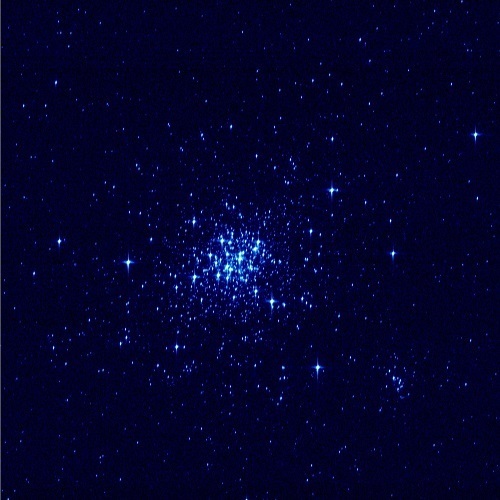
Image: A calibration image from Gaia is part of early testing of the mission’s systems. Credit: ESA/DPAC/Airbus DS.
Gaia inevitably makes me think of Hipparcos, an earlier ESA mission launched in 1989 devoted to precision astrometry, the measurement of proper motions and parallaxes of stars to help us figure out their distance and tangential velocity. What a far cry Hipparcos was from the days when Thomas Henderson, then observing at the Cape of Good Hope, was trying to measure the parallax of Alpha Centauri, all the while dueling with the German astronomer Friedrich Wilhelm Bessel to demonstrate that the method could give us a distance measurement to a star.
Bessel’s work on 61 Cygni took precedence but both astronomers proved that the closest stars could be measured using the instruments of their day. But measuring star positions from the ground has always been tough thanks to atmospheric effects and instrument limitations. And as we looked further and further from our own stellar neighborhood, these methods grew more challenging still, which is why proposals for a space mission devoted to astrometry began as early as 1967. The Hipparcos Catalog was released in 1997, covering precise measurements of almost 120,000 stars, with less precise readings on about a million more.
Now we have Gaia, which will chart 10,000 times as many stars as Hipparcos, with measurements of their position and motion that are 100 times more accurate. If all goes well, we should wind up with the largest three-dimensional map of the Galaxy ever created, charting one billion stars in terms of their distribution, brightness, temperature, composition and motion. Gaia should firm up our understanding of galactic structure while making numerous exoplanet finds and uncovering vast numbers of brown dwarfs. We can expect measurements of 500,000 quasars in the distant universe and, much closer to home, data on new asteroids.
It’s an ambitious mission, one that contains twin optical telescopes and their imaging system, a radial velocity spectrometer and blue/red photometers. The telescopes will focus their light onto a 106 CCD focal plane array with almost one billion pixels, making Gaia’s the largest digital camera yet deployed in space. The two telescopes will monitor each target star about 70 times over the five year mission, sweeping the entire sky in the process, their repeated measurements teasing out the parallax and true motion of each object. Objects down to magnitude 20 are in range, and according to this ESA backgrounder, the accuracy will range from 20 percent for stars near galactic center to 0.001 percent for stars closest to the Solar System.
Every one of Gaia’s billion stars will have been observed in the first six months of operations once calibrations are completed, but it’s the repeated observations over five years that will allow accurate determination of stellar distances and motion, with the final catalog not scheduled to be released until three years after the end of the mission. We need to keep a close eye on Gaia. It is essentially bringing our fuzzy maps of the Milky Way into much higher resolution, with implications for existing work like Kepler’s — Gaia will be able to give us accurate information about distance and motion for the planet-bearing systems Kepler has thus far found. A million gigabytes of data are in store as Gaia’s enormous catalog deepens our view of the galaxy.






February 17, 2014
Asteroid Re-Direct: Finding a Candidate
It was just a year ago, on February 15, 2013, that the 30-meter asteroid 2012 DA14 whisked past the Earth at a distance of well less than 30,000 kilometers, inside the orbits of our geosynchronous satellites. If you don’t recall 2012 DA14, it’s probably because it was later on the same day that the Chelyabinsk impactor struck, a 20-meter asteroid that released the energy of approximately 460 kilotons of TNT. Chelyabinsk made it into 2014 Olympic news at Sochi, with ten gold medals for February 15 winners being embedded with fragments from the object.
Today we get the passage of near-Earth asteroid 2000 EM26, whose closest approach will be covered by the Slooh network of automated telescopes starting at 2100 EST (0200 UTC), live from the Canary Islands. An iPad app is available or you can watch on Slooh.com, with the live image stream accompanied by commentary from astronomer Bob Berman and guests discussing the event and fielding questions from viewers using the hashtag #asteroid. Berman notes the significance of asteroid tracking and developing future mitigation strategies:
“On a practical level, a previously-unknown, undiscovered asteroid seems to hit our planet and cause damage or injury once a century or so, as we witnessed on June 20, 1908, and February 15, 2013. Every few centuries, an even more massive asteroid strikes us — fortunately usually impacting in an ocean or wasteland such an Antarctica. But the ongoing threat, and the fact that biosphere-altering events remain a real if small annual possibility, suggests that discovering and tracking all NEOs, as well as setting up contingency plans for deflecting them on short notice should the need arise, would be a wise use of resources.”
The Challenge of Asteroid Capture
With almost 11,000 near-Earth objects now discovered, the astronomical community continues its work on planetary defense. The Asteroid Redirect Mission (ARM) is NASA’s bid to find a small asteroid that can be parked in a lunar orbit for study and thorough exploration in the 2020s. This JPL news release gives us more information about ARM’s current status, noting two possible scenarios: An entire small asteroid could be captured and redirected into lunar orbit, or a large boulder or other mass from a larger asteroid could be retrieved and put into a similar orbit.
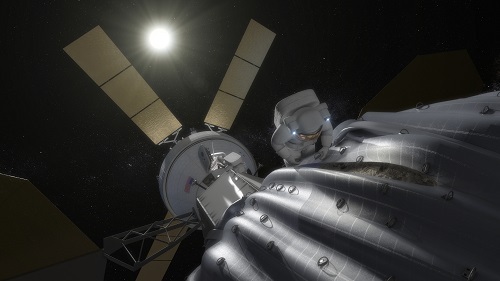
Image: This concept image shows an astronaut preparing to take samples from the captured asteroid after it has been relocated to a stable orbit in the Earth-moon system. Hundreds of rings are affixed to the asteroid capture bag, helping the astronaut carefully navigate the surface. Credit: NASA/JPL.
But finding the right asteroid is tricky business. Most near-Earth asteroids are either too large or in unsuitable orbits, and would-be targets can move out of range of our instruments so fast that it becomes a challenge to get enough data to make the call. The goal is something smaller than about twelve meters across, says Paul Chodas, a senior scientist in the Near-Earth Object Program Office at JPL. He adds: “There are hundreds of millions of objects out there in this size range, but they are small and don’t reflect a lot of sunlight, so they can be hard to spot. The best time to discover them is when they are brightest, when they are close to Earth.”
The news release goes through the detection and analysis process. The coordinates of objects detected by asteroid surveys flow to the Minor Planet Center in Cambridge, MA, where the objects can be tagged as previously known or else given a new designation. Orbit, intrinsic brightness and other data are then refined by the Near-Earth Object Program Office at JPL, which updates its online small body database. Now in place for the projected asteroid redirect mission is a new screening process that scans for candidate objects.
Radar observations by the Deep Space Network at Goldstone (CA) or Arecibo Observatory in Puerto Rico can produce further data on orbit and size if they are able to track the asteroid, but other observatories both professional and amateur may also be asked to look at it. The Infrared Telescope Facility at Mauna Kea can provide details on spectral type, reflectivity and likely composition. Several dozen 6- to 12-meter asteroids are thought to fly by the Earth at a distance closer than the Moon every year, but few of these are in suitable orbits for the ARM mission.
Even so, the wave of new technology now approaching should make finding the right object a sure thing. Lindley Johnson (Near-Earth Objects Program, NASA headquarters) notes what we can expect:
“The NASA-funded Catalina Sky Survey, which has made the majority of NEO discoveries since its inception in 2004, is getting an upgrade. We also will have new telescopes with an upgraded detection capability, like PanSTARRS 2 and ATLAS, coming online soon, and the Defense Advanced Research Projects Agency’s new Space Surveillance Telescope will give us a hand as well.”
And don’t forget our old friend WISE, which I usually write about in terms of brown dwarfs in the Sun’s vicinity. The repurposed spacecraft now functions as NEOWISE and may help in characterizing targets for the redirect mission.
Potential candidates are being flagged at the rate of about two per year, a number that is bound to climb as these further resources come into play. We’ll then have a target and a plan as we proceed in our efforts to characterize these objects. NASA is assuming that an Orion spacecraft and Space Launch System (SLS) rocket will make asteroid capture happen, but whatever the hardware, studying small asteroids up close — and ultimately developing strategies for nudging the trajectories of much larger objects — is a vital part of future planetary defense.






February 14, 2014
Starships on Earth
Building a starship takes us along an evolutionary path as we master the myriad methods of its creation. And the process does not start at some arbitrary point in the future. Rather, it begins now as we put today’s technologies to work in the service of new concepts. Living ‘meta-technologies’ offer a way into the enclosed but verdant spaces of a worldship. In the essay below, Centauri Dreams regular Rachel Armstrong looks at current projects that explore the kind of biospheres a worldship will entail, and discusses enriched ecosystems that form ‘a new kind of Nature.’ Dr. Armstrong is co-director of AVATAR (Advanced Virtual and Technological Architectural Research) in Architecture & Synthetic Biology at the University of Greenwich, London. She completed clinical training at the John Radcliffe Medical School at Oxford in 1991, and in 2009 began PhD work in chemistry and architecture at University College London.
by Rachel Armstrong

“Why are you crying grandma?”
“I’m not!” The old woman quickly rubbed the back of her hand over a thin gleaming trail on her cheek. “There’s a lot of dust in the air thrown up by those sky hooks! They’re on the move again!”
Several teams of construction workers were using hover diggers to loosen the foundations of what looked like a small hill. They chopped into the humus like a pack of dogs looking for bones, levering sections of earth upwards before finding a new soil horizon to work on. Gradually, they started to expose a porous rock-like framework that was heavily covered with vegetation and subterranean organic matter.
“Where are they taking the Green Hollow now?” asked the child, as troupes of day-glow labourers swung by safety threads from the steel grabber that was making clumsy pinching movements above them.
The afternoon sun was making it difficult to see the details of the architecture, which was rising like a great shadow over the landscape. It no longer appeared green but black, except for where chemically sculptured nurturing light tracks passed through it.
“Up to Persephone, way beyond Earth’s orbit,” replied the old woman. “They’ve been growing the organs for that worldship interior for as long as I can remember. When I was your age, I even remember helping the boiler-suited workers plant the solutions by hand that would form her bones and tissues in the ground beneath us now. They told me that if I looked after them and kept them well fed with scraps of organic matter, then the Green Hollow would grow up big and strong.”
“Like feeding ducks?” asked the child.
The old woman nodded. “Yes, but you have to sow the duck seed to grow the birds first – then feed them!”
…………………………………………
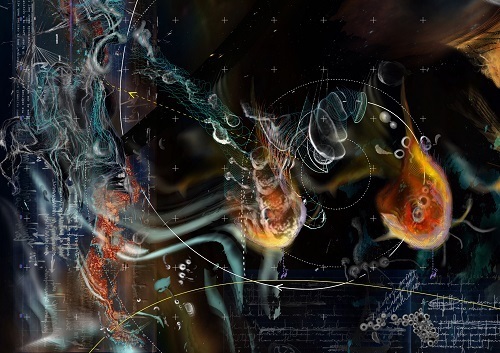
Image: This and other artwork in this essay by Elizabeth Anne Williams.
If we are unable to live ‘sustainably’ on a life-bearing planet – then how do we propose to live amongst the stars, or construct environments so they may become fertile – such as worldships?
At the start of the third millennium we are entering the next stage of human expansion. The scale and speed of our development, with the global spread of industrial processes, is catalyzing a new stage of metabolic evolution for R. Buckminster Fuller’s readymade ‘spaceship earth’ [1]. Yet, the industrial processes that support our growth are collectively ‘reverse terraforming’ our native life support system, such as by releasing stored carbon dioxide from fossil fuels on geological scales [2]. While James Lovelock and Lynn Marguils observed that Earth’s biosphere is a self-regulating system [3], its ability to respond to challenges operates within definable limits and the pressure of human development appears to currently be exceeding the homeostatic capabilities of our planetary system. Specifically, after 150 years of industrialization, our natural systems are being drained to feed our rapidly expanding urban populations with life-sustaining water, fertile soils and minerals [4]. Indeed, owing to the fundamental nature of these infrastructures, space engineering and architecture converge on the shared challenges in designing our life-support systems – which are centred on the issue of ‘sustainability’.
Sustainable development is a relatively new concept that has been emphasized by an awareness of resource constraints in the late 20th century. It invites questions about how current generations can meet their own needs as well as securing the welfare of future generations. Yet, the 1987 Brundtland Report [5] uses general terms to describe the nature of ‘sustainable’ development – as enabling the current generation to meet its own needs without compromising the ability of future generations to provide for themselves. This has precipitated a variety of different approaches to achieve these aims in the practice of the built environment ranging from the biological metaphors of biomimicry, to the decoration of our living spaces with elements from rural vistas in green roofs and walls.
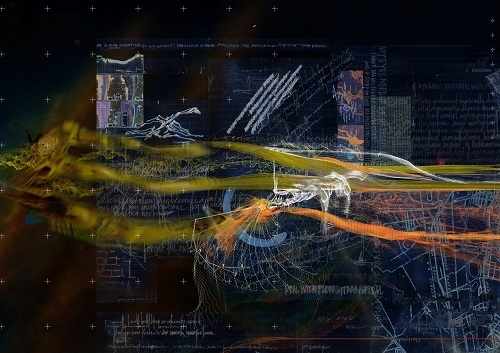
Some methods incorporate the conservation of materials or resources, while others explore a variety of ways to improve the mechanical efficiency of systems. So, when considering a long-term pathway for establishing models of sustainable development, it is worth remembering that the concepts and practices that form ‘sustainable’ narratives are still very much in evolution.
Yet, the prevalent paradigm of sustainability operates according to the principles of resource conservation and operates as a ‘better’ kind of industrialization. In the absence of approaches that directly enrich our ecosystems, we are compromising the ability of generations to provide for themselves. Indeed, only a very few systems have been designed that can support sustained living in resource constrained environments. These ‘biospheres’ are technologically constructed, closed and controlled experiments, which propose to help us manage the Earth’s resources better. Potentially they enable us to establish ecosystems beyond the Earth’s surface and include projects such as BIOS-3 [6] and Biosphere 2 [7]. The price of these constructed environments helps append a monetary value to the services provided by natural ecosystems. For example, the International Space Station, which may be regarded as a biosphere that is regularly topped up with fresh resources, has cost between $100-150 billion [8] and during the Biosphere 2 project $9,000,000 was spent on each crew member per year [9].
Yet, such valuations cannot convey the investment made by Earth’s systems in producing a life-bearing planet. These have been made over billions of years through processes that we do not fully understand. The outcome of these natural systems is a range of priceless technologies that are formed from the integration of natural forces, which transform one set of substances into another through the process of metabolism and include soils, forests and crude oil [10]. Recently, we have been able to manipulate living systems at such small scales and with such precision that we are starting to understand how we may apply living processes as a kind of 21st century technology in ways that reinforce the actions of natural systems. By developing this new toolset potentially, in the longer term, human development may be synonymous with an increase in planetary fertility.
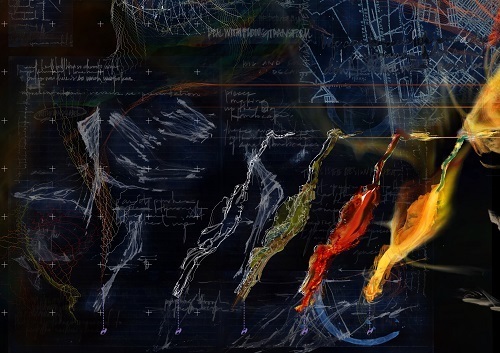
‘Ecopoiesis’ is the science that studies the transformation of inert terrains such as the Martian surface into life-bearing ones [11].To facilitate the production of life-promoting systems, these principles could also be applied to other lifeless terrains, such as metallic starship interiors, or the concrete surfaces of cities.
Indeed, life-enhancing habitats are a fundamental requirement for architectural projects in resource-constrained environments, and many principles can be explored on Earth’s surface without incurring the costs and extra degrees of technological difficulty associated with building non-terrestrial habitats. Indeed, an experimental approach to the design of buildings to increase environmental fertility and promote new ways of thinking about closed ecological systems could be developed by multi-disciplinary teams of researchers where multiple stakeholders – from space agencies, to property owners – may benefit from the construction challenges, ecological discoveries and post-occupancy evaluations in the pursuit of life-promoting architectures. While some novel materials with lifelike properties already exist as commercial products, such as Mycoform [12], which is a building material produced from compacted fungal mycelium, many innovations in bioprocessing are still prototypes. This presents a wealth of new opportunities for the exploration of new concepts in sustainability.
One such project is a collaboration between Astudio architects, Sustainable Now Technologies, AVATAR (Advanced Virtual And Technological Architectural Research) group at the University of Greenwich and the students at the Twickenham Academy in London, which applies an experimental algaeponics technology – the Greenstone Device – in an architectural context. This prototype cutting edge biotechnology system was designed specifically for the Twickenham Academy 6th form as a way of fixing 1 metric ton of carbon every 2.2. years. The facility provides students with access to state of the art, sustainable technology that forms the basis for unique project work that are integral to the 6th form curriculum. Students use the Greenstone Device to strudy the economics of carbon capture to the range of products generated by the technology.
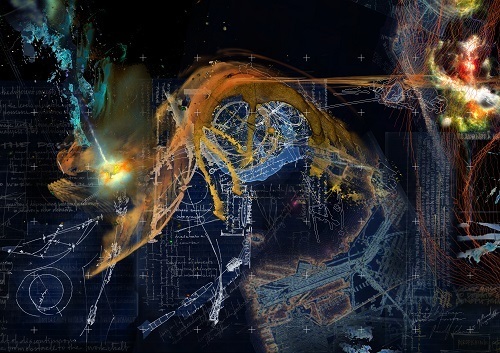
The questions raised by this integrated algaeponics project may be relevant to space programs – in the short and long term – that are investigating the possibilities of aqueous ecosystems in extra-terrestrial environments. For example, the European Space Agency’s MELISSA (Micro-Ecological Life Support Systems Alternative) project, seeks to produce food and reclaim minerals, water and oxygen through bioprocessing systems using waste matter such as, faeces, urea and carbon dioxide [13]. Extending the space research into terrestrial settings through a combined research program could expand our knowledge of constructing closed system ecologies and help develop next generation expertise in a new portfolio of materials, infrastructures, technologies and economic models. These may help us develop life-promoting habitats across a range of environments that span from the Earth to the stars.
Yet the impacts of possible new fusions and collaborations may also produce more immediate impacts on our urban living spaces, since lifelike technologies require similar kinds of infrastructures to fully alive systems. For example, bioprocesses require circulation of nutrient supplies through streams of air and water, which could take place within the walls of our homes [14]. Setting up non-equilibrium conditions within the fabric of our buildings enables them to be more than containers for living processes but to act as bioprocessing sites, which can perform a whole range of useful tasks that can be thought of as extended ‘organs’ to digest waste, recycle water, remove environmental toxins and even provide food for their inhabitants.
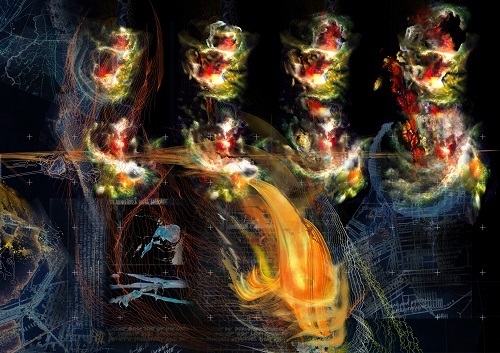
Moreover, lively building fabrics with metabolisms and physiologies do not need to be monstrous edifices. They could constitute a quiet revolution, which is locally produced and shaped by maker communities of bio hackers that are already developing experimental prototypes in their bedrooms, such as Cathal Garvey’s synthetic biology laboratory in Cork [15]. They may simply creep up quietly on our living spaces to infiltrate forgotten and under imagined spaces such as roofs, cavity walls and gaps under floorboards. Nor do they have to exist without aesthetic sensibilities. The Dutch electronics company Phillips proposes that our next generations of biochemical digesters will be so beautiful they will be on display in our homes. For example, bioluminescent bacteria may be housed in vials of beautiful hand-blown glass cells, which use waste that is generated in the average home to produce low-level, mood-elevating light [16].
Indeed, an immediate investment in developing the conceptual and technological infrastructures to produce life-promoting environments may have far reaching benefits in the long term – where buildings are sites for micro agricultures that produce rich, fertile fabrics, such as soils and coral reefs. In turn, these may provide a native infrastructure that possesses the richness and diversity that enrich existing ecosystems and could be considered to exist within a spectrum of natural processes as a new kind of Nature. Indeed, the mutually reinforcing approaches that exist at the intersection between space research and sustainable architecture, may help us better understand how to design, engineer and inhabit closed system ecologies through the design and prototyping of post natural fabrics, which could be prototyped within the everyday context of our swelling cities. For example, the opportunities for material fertility within micro sites may be enhanced by orchestrating the flow and transformation of matter through them in a large range of forms such as, synthetic soils grown from complex chemistries, entanglements of silicon circuitry and cell cultures, or green plants with bead-like metallic micro batteries.
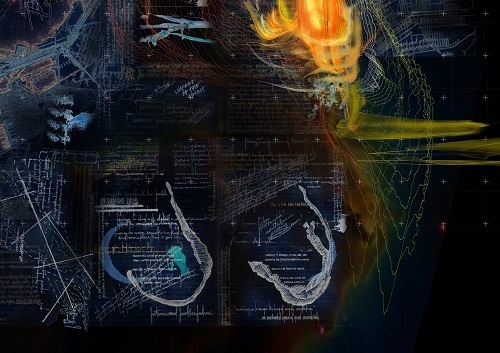
These heterogeneous fabrics may eat with us, breathe, age and feel alongside us. They may process our biochemistry as if they were our own native extended organs and embody aesthetic preferences that convey our desires and betray our emotions because they are woven through our own design. Indeed, the diversity and versatility of their configurations may not only help us increase the liveability of our surroundings and establish fundamental principles for the construction of synthetic ecosystems in every conceivable environment but offer us new survival strategies that support this current wave of human expansion. Yet, we do not have to wait for starships to be realised before we conduct these ecological experiments. Rather we can create a liveable legacy for today’s sustainability challenges by changing our expectations of our cities, habitats and ecosystems to create new, evolvable foundations that weave together the territories between the Earth and stars through living toolsets.
The developments that take us beyond this planet do not need to be conducted within a vacuum. Indeed, it makes economic and scientific sense to prototype new ideas within the resource-challenged sites of our current cities, where our learning can be extended across generations of architects, engineers and scientific researchers. The outcomes of these explorations will inform the construction principles, substrates and technologies necessary for the development of habitable worldship interiors and the principles that will enable us to transform barren environments into ones that can support new kinds of life. Indeed, weaving starship fabrics into our cities will enable us to seed life throughout the cosmos, long before the first colonies ever leave our home planet.
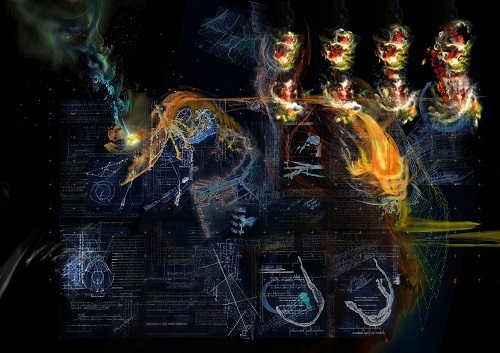
…………………………………………
“It’s scary!” remarked the child, gripping his grandmother’s hand.
“I suppose so.” Mused the old woman, noting how the striking absence of life made the gaping hole where the Green Hollow had once been seem particularly ominous. “But, they’ll start to fill it with duck seed soon!” She smiled reassuringly.
Two skyhooks appeared to walk like giants towards them, rocking in their seven league boots above the horizon. Both grips were clutching tankers of fluid. The day-glow crews moved like spiders on threads between them, guiding and cajoling the monsters until they towered over the cavity in the ground.
An all-terrain-vehicle drove up to the bystanders and an official wearing a peaked olive green cap barked at them to stand back and mind the spray when the tanker contents were discharged into the quarry. He handed them some porous paper face masks, which made everyone look like chickens.
“Planting a new structure was a much simpler operation when I was young!” remarked the grandmother under her paper beak, as the boy wondered what kinds of adventures he might have in a hard peaked hat.
Several long, thin-legged walkers braved the rich spray as the tanker contents were discharged. They deftly folded several layers of a football-pitch sized membrane into the rapidly filling hole that was impregnated with bacterial spores. As the waters rose, the walkers’ legs retracted and became cantilevers that braced their bodies in a flotation formation. They continued to knit and tuck the membranes into the fluid as they also seeded and folded hardy microorganisms in the muddy eddy of the uterine pit. Yet, unlike the lifeless scar left by the quarry, the goo itself was vibrant, feeding and evolving. Even within the first minutes of its existence, strange tubular embryonic forms were starting to yaw, roll and involute like a rising cake mix. By the time the walkers stretched their legs again, the contents of the pit had set like a gel and small birds were nervously landing on its trembling surface, gorging on eluted earthworms.
“Is all the seed in the hole now?” asked the boy.
“I think so,” replied his grandmother as the official swung his arm low, motioning to the public that they could remove their face shields.
“So, what happens now?”
“We wait,” she said.
——-
References
[1] Fuller, R.B. 2008. Operating manual for spaceship earth, Zürich: Lars Muller Publishers.
[2] US National Research Council. 2010. Advancing the science of climate change, America’s climate choices. Washington: National Academies Press. [online] Available at: [Accessed 18 April 2013]. p3.
[3] Lovelock, J. 2000. Gaia: A new look at life on earth, Oxford: Oxford Paperbacks.
[4] Lovelock, J. 2009. The vanishing face of Gaia, New York: Basic Books.
[5] World Commission on Environment and Development.1987. Our common future. Report of the World Commission on environment and development. Published as Annex to General Assembly document A/42/427. Available at: http://www.un-documents.net/our-common- future.pdf. [Accessed 25 April 2013].
[6] Prado, M.E. 1983-2003. Russian CELSS Studies. [online] Available at: http://www.permanent.com/russian-cels.... [Accessed 22 December 2014].
[7] Avise, J.C. 1994. The real message from Biosphere 2, Conservation Biology, 8(2) pp. 327-329.
[8] European Space Agency. No date. How much does it cost? International Space Station? Human Spaceflight. [online] Available at: http://www.esa.int/Our_Activities/Hum...
How_much_does_it_cost. [Accessed 22 December 2013].
[9] Avise, J.C. 1994. The real message from Biosphere 2. Conservation biology, 8(2), p. 327-329. See also Keim, B. 20 April 2009. Biosphere 2 not such a bust. Wired. [online] Available at: http://www.wired.com/wiredscience/200.... Available 26 December 2013].
[10] I am applying the term ‘technology’ to refer to a total cosmic infrastructure of artificial and natural forces that may be harnessed to perform useful work. Heidegger, M. 1978. Being and Time, New Ed. Oxford: Wiley-Blackwell.
[11] Fogg, M.J., “Dynamics of a Terraformed Martian Biosphere,” Journal of the British Interplanetary Society, 46, 293-304 (1993).
[12] Mycoform. No date. Terreform. [online] Available at: http://www.planetaryone.com. [Accessed 27 December 2013].
[13] MELISSA. 8 February 2006. Advanced Life Support, European Space Agency. [online] Available at: http://ecls.esa.int/ecls/?p=melissa. [Accessed 27 December 2013].
[14] This possibility was discussed earlier in a piece on Living Technology.
[15] Regalada, A. 14 February 2012. Doing biotech in my bedroom. MIT Review. Available at: http://www.technologyreview.com/news/.... [Accessed 27 December 2013].
[16] Muppala, S.C. 1 December 2011. Glowing Bioluminescent Bacteria Brings Hope of a New Power-efficient Lighting System. Medindia [online] Available at: http://www.medindia.net/news/Glowing-.... [Accessed 12 September 2013].






February 13, 2014
Mapping Ganymede
The first global geological map of Ganymede has become available through the efforts of a team led by Wes Patterson (Johns Hopkins Applied Physics Laboratory) and Geoffrey Collins (Wheaton College). The map doesn’t reproduce well in the small space I have available, but the image below gives you an idea of its layout and is linked to the download site at the U.S. Geological Survey, which is publishing it as USGS Scientific Investigations Map 3237.
Image: Ganymede is the largest satellite of Jupiter, and its icy surface has been formed through a variety of impact cratering, tectonic and possibly cryovolcanic processes. Images of Ganymede suitable for geologic mapping were collected during the flybys of Voyager 1 and Voyager 2 (1979), as well as during the Galileo mission in orbit around Jupiter (1995–2003). This map represents a synthesis of scientists’ understanding of Ganymede geology after the Galileo mission. Credit: Wheaton College/JHUAPL/Brown University/JPL/USGS.
Ganymede is now the fourth planetary satellite to be mapped after our own Moon as well as the Jovian satellites Io and Callisto, a feat made possible by synthesizing data from multiple missions including the Voyagers and Galileo. The striking nature of Ganymede’s terrain is obvious from the contrast between lighter regions marked by grooves and ridges and apparently older, darker cratered areas. A map like this reminds us that the features we’re looking at are evidence not only of the moon’s internal changes but its interactions with the other Galilean satellites and the various small objects that have impacted its surface along the way.
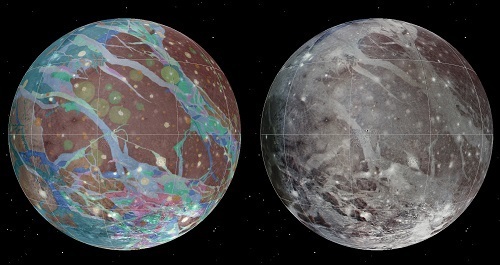
Image: To present the best information in a single view of Jupiter’s moon Ganymede, a global image mosaic was assembled, incorporating the best available imagery from Voyagers 1 and 2 and Galileo spacecraft. This image shows Ganymede centered at 200 west longitude. This mosaic (right) served as the base map for the geologic map of Ganymede (left). Credit: USGS.
Good maps, of course, are always refined as we collect better data, and on that score, we’re continuing to follow the fortunes of JUICE, the Jupiter Icy Moons Explorer, a planned European Space Agency mission selected in May 2012 with a proposed launch in 2022, arriving in the Jovian system in 2030. While JUICE is going to be studying Callisto and Europa as well, the plan is for the spacecraft to enter orbit around Ganymede after its other maneuvers in the system. A possible Ganymede Lander mission from the Russian Space Research Institute is also in the cards, although whether it becomes a partner to JUICE or flies at all is still in question.
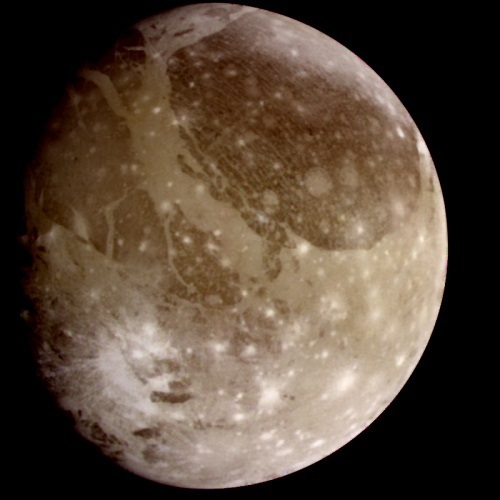
Image: This is a natural color view of Ganymede from the Galileo spacecraft during its first encounter with the satellite. North is to the top of the picture, and the sun illuminates the surface from the right. The dark areas are the older, more heavily cratered regions, and the light areas are younger, tectonically deformed regions. The brownish-gray color is due to mixtures of rocky materials and ice. Bright spots are geologically recent impact craters and their ejecta. The finest details that can be discerned in this picture are about 13.4 kilometers across. The images that make up this color photo were taken in June 1996. Credit: NASA/JPL.
The three moons to be visited by the JUICE mission are all the site of possible oceans beneath their ice, governing the instrument choices aboard the spacecraft, which will include cameras, spectrometers, a laser altimeter and an ice-penetrating radar. A dozen flybys are planned for heavily-cratered Callisto, and the mission’s two flybys of Europa will include measurements of the thickness of the ice crust. Settling in by 2033 into orbit around Ganymede, JUICE will not only study the moon’s structure but its magnetic and plasma interactions with Jupiter. Ganymede is the only moon in the Solar System known to generate its own magnetic field.

Image: NASA’s Pluto-bound New Horizons spacecraft spied Jupiter’s moon Ganymede on February 27, 2007, from 3.5 million kilometers (2.2 million miles) away. The original scale was 17 kilometers per pixel, and the image is centered at Ganymede coordinates 6 degrees south, 38 degrees west. Ganymede, the largest moon in the solar system, has a dirty ice surface cut by fractures and peppered by impact craters. Credit: NASA/JHUAPL/Southwest Research Institute.
I include the image above because it’s a reminder how reliant we are on a small number of missions to get the data needed for the Ganymede map. We can only hope that JUICE flies per schedule and delivers what would obviously be a major data upgrade. Meanwhile, seeing the New Horizons image of Ganymede, taken as the spacecraft whisked past the Jovian system in 2007, gives renewed cause for celebration that all systems aboard that craft are sound as we prepare for next year’s flyby of Pluto/Charon and, let’s hope, a KBO encounter beyond.






Paul Gilster's Blog
- Paul Gilster's profile
- 7 followers



